In the current era, social media integration along with augmented reality (AR) is continuously changing the way users use their favorite apps.
The adoption of augmented reality adds digital elements to what the user sees in real life via phone cameras.
AR and VR are techs that add digital stuff to the real world that makes everything more exciting. Additionally, AR brings digital elements into the actual surroundings.
Want to learn more about the role of AR and VR in social media apps?
Let’s cover it all in this blog.
Understanding AR and VR in Social Media: Market Size and Key Statistics
Before we proceed further, let’s evaluate the role of AR and VR in social media apps along with the current market statistics.
The adoption and implementation of AR and VR technologies can create immersive as well as interactive experiences for social media users.
Additionally, the adoption of AR can reveal digital elements in the real world. However, VR adoption helps transport the users into a simulated environment.
Implementing AR and VR may offer different advantages for social media including user attention and retention via more immersive and realistic content.
The adoption of such technologies helps the brands offer a unique and personalized experience including virtual try-ons along with immersive product demos that help to boost overall consumer engagement.
Revenue in the AR & VR market worldwide is projected to reach US $46.6 billion in the year 2025.
Additionally, the revenue is expected to reach an annual growth of 7.42% leading to a projected market volume of US $62.0 billion by the year 2029.
Additionally, the global VR market size is valued at USD 16.32 billion in the year 2024. This market is expected to grow from USD 20.83 billion in the year 2025 to USD 123.06 billion in the year 2032.
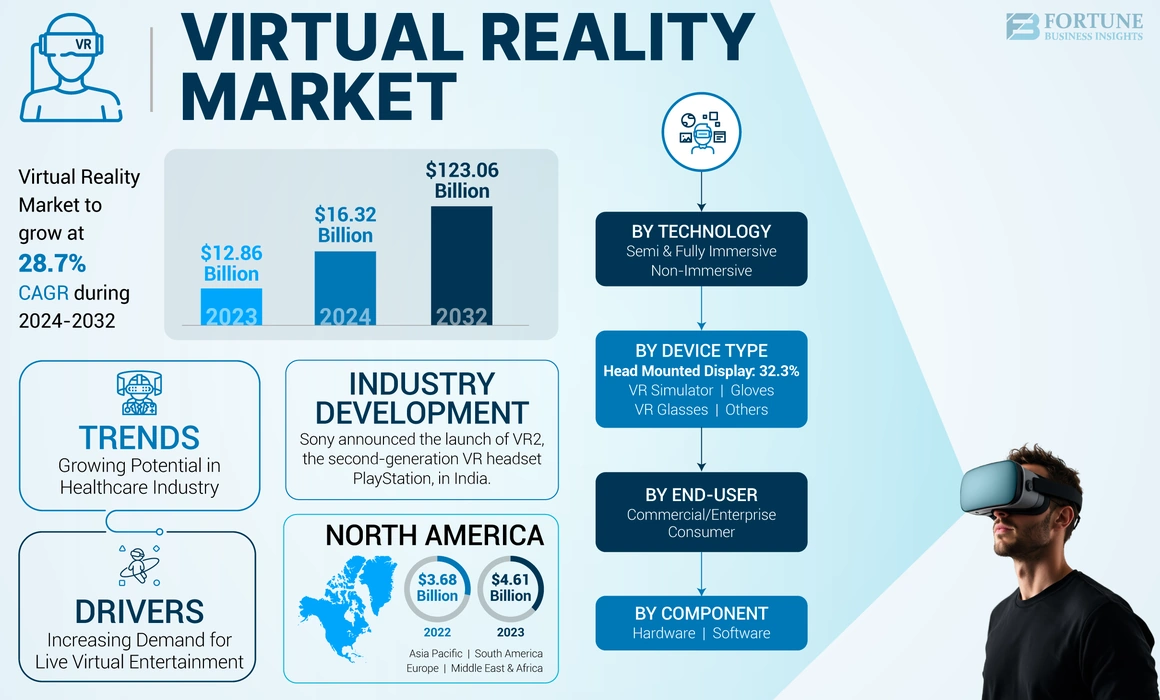
Social media usage is one of the important and popular online activities. In the year 2024, there were over 5 billion people were using social media worldwide, and this number is further projected to increase to over 6 billion in the year 2028.
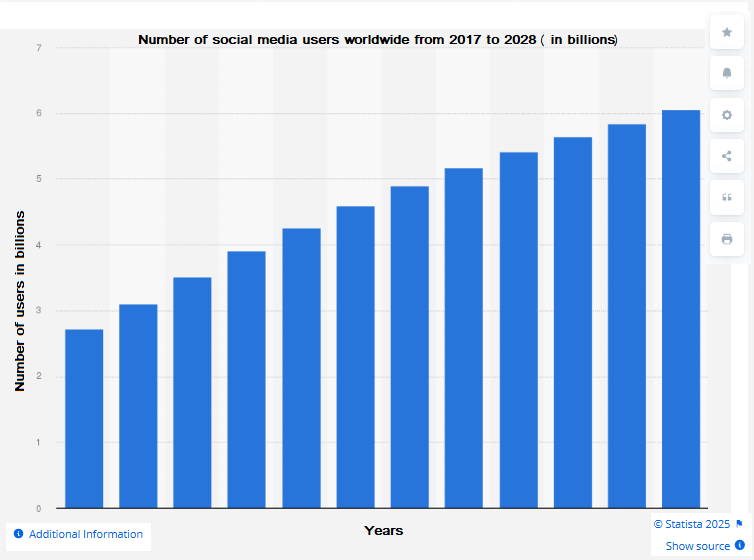
The social network platforms’ total user base in the previous decade has grown from 2.08 Billion in the year 2015 to 5.24 billion users in January 2025.

Additionally, on average, the social media user engages with an average of 6.83 over different social media platforms.
With the help of AR and VR, viewers can connect with the events even if they are far from the place through the use of digital connectivity and the adoption of AR and VR.
This data represented that the implementation of AR and VR in social media apps has impacted the growth of such platforms over the decades.
The adoption of AR and VR technologies in the apps is resulting in making live events more interactive.
Are you the one who wants to create an AR-VR-based social media app?
Then, let’s proceed with the following section.
Development Process of AR and VR Based Social Media Apps
How to build an AR and VR-based social media app?
Under this procedure, you need to connect with the following sequence of steps.
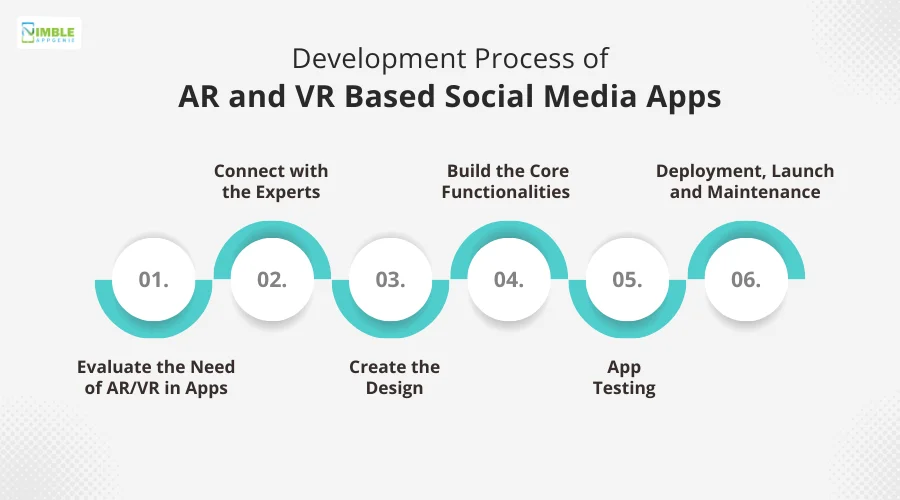
Step 1. Evaluate the Need of AR/VR in Apps
One of the important segments to note here is to identify the role of AR and VR in social media apps.
Here you should conduct market research that will help you to identify what’s the need for the latest technologies to be implemented in your app.
Along with this, the use of AR/VR within social media campaigns can assist in attracting users to the brand.
Well, it will depend on the current need of your social media app and project in the competitive environment.
The implementation of AR is revolutionizing user interactions along with mobile app interfaces, however, you need to adopt and implement these technologies based on the current requirements of the environment.
Step 2. Connect With the Experts
Now, it is time to connect with the top experts when it comes to creating a social media app that is based on AR/VR technologies.
You can connect with the top experts who can help you implement the AR/VR technologies in your dream app.
Under this step, you should hire mobile app developers, only after examining the location and skills of the developers.
You can state your requirements with these experts and can discuss all the essential elements with the users. It will help you lead the industry and to know the views of the users.
Step 3. Create the Design
Here, it’s all about considering mobile app design. Under this step, the complete design of the app should be simple and yet attractive to engage potential users.
When it comes to social media app design, you can include AR-VR technologies only after evaluating their need for your app.
Under this segment, you can go through developing the wireframe and prototype of your social media app that will help to develop an infrastructure.
Step 4. Build the Core Functionalities
Now, it’s time to create the core functions for your app. This will be useful in identifying the core functions that will be based on the project objective.
Here the social media tech stack should support the adoption and implementation of the latest technologies such as AR and VR in the mobile app.
Along with this, here you should include all the different technologies and stacks such as Kotler, and Swift, based on the type of platforms (Android or iOS).
Step 5. App Testing
You cannot launch your social media app based on AR/VR until it’s being tested rigorously. It is one of the important steps that you can’t ignore.
Through regular mobile app testing, you can continue leading the current industry. It will be one of the crucial segments that can’t be ignored.
This segment will help you to identify any potential bugs or errors that can impact the complete social media app based on AR/VR development.
Step 6. Deployment, Launch and Maintenance
Now, as the app development process for your AR/VR based social media app is completed. You should deploy the app on the selected platform and then launch the app accordingly.
Well, after the launch, it’s time to go for the mobile app maintenance process. Here all you can do is include the app maintenance tools which will help you to sustain the competitive market.
It is one of the steps that you can’t miss as it’s a never-ending process and will help you to know the market and then update the social media app accordingly.
Considering these steps, you can continue to create an AR/VR based social media app.
If you are still confused about why to include AR/VR in social media apps, then learning about the benefits of implementing them in the app can be helpful.
Let’s cover them all in the given section.
Benefits of Integrating AR and VR into Social Media Platforms
When you step into the social media industry, we understand that you need to evaluate and know every detail about the same.
Well, if you are afraid to adopt AR/VR here, these are some of the benefits that can be considered.
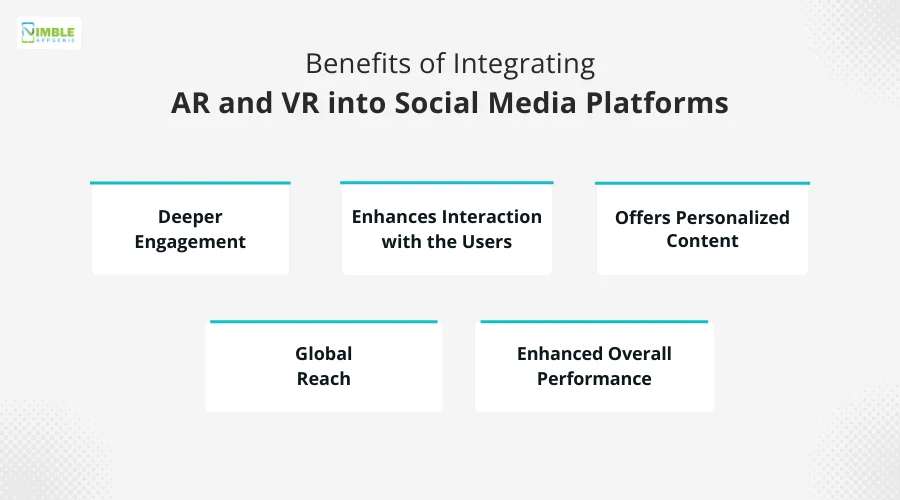
► Deeper Engagement
The adoption of AR and VR in the social media app will create an immersive, interactive experience for the users. Here the viewers can become active participants rather than passive observers.
With the adoption of AR/VR, businesses can reshape social media marketing by offering an immersive experience that might engage users in novel ways.
► Enhances Interaction With the Users
AR/VR technology focuses on delivering an interactive and immersive experience. Through social media apps, you can connect with the target audience successfully.
This will be even helpful in building a regular and long-term interaction with the users.
Along with this, the users can organize contests and competitions to encourage them users to regularly engage with the social media app.
It does help to regularly evaluate the current needs and then provide them with effective features as per their requirement.
► Offers Personalized Content
The implementation of AR and VR in social media apps can further be useful in offering personalized content.
By integrating AR and VR into best social media platforms, the brands may transport the overall audiences into captivating environments.
It helps in delivering personalized content and helps in driving business interactions forward.
With the help of AI, social media businesses can collect a wide amount of data then this can be used for enhancing the user experience via AR and VR.
► Global Reach
With the help of AR/VR in social media apps, the app can bring people together from around the world. The adoption of VR can bring people together from around the world.
Virtual meetups, conferences, along social gatherings may break down the geographical barriers.
It will help your app to reach the targeted audiences. This will further be helpful for your app to enhance inclusive interactions.
These implementations in social media do offer an innovative initiative for increasing user interactions with the app.
► Enhanced Overall Performance
AR-VR-based social media apps will automatically gain more attention from the users rather than an app that doesn’t contain these elements.
It does help the users to have new storytelling tools that help the users to create an immersive narrative that engages their audience for the long term.
With the help of AR/VR, the users can become active participants in their own learning, by enhancing deeper cognitive engagement and improving knowledge retention.
These were some of the benefits that should be undertaken when you proceed to create an AR and VR based social media app.
Till now, we have analyzed the concept of AR and VR in social media apps, along with the social media app statistics, development process, and benefits to include within the app.
Now, let’s examine the top features of AR/VR in the social media apps that you can include within the app. You can learn it all in the given section.
Key Features of AR and VR in Social Media Apps
You should implement the top social media features to enhance the overall performance of your dream app.
When it comes to AR, it is a combination of digital and physical worlds, along with interactions made in real-time, and with accurate 3D identification of the virtual and real objects.
For social media apps, the use of AR/VR can help retain potential users.
How?
Well, the adoption of AR can help in making real-time interactions with the target audience.
Now, when it comes to VR, the technology helps build immersion, interaction, realistic visuals, and spatial audio, with the multi-sensory haptic feedback.
The adoption of VR in social media apps can help add realistic visuals and interactions and help the users add cool filters, such as trying on clothes virtually and even exploring 3D objects.
Well, in this way, the features of AR/VR technologies in social media apps can help enhance the overall performance of the users.
Now, let’s proceed forward with the top challenges and solutions while adopting AR/VR in social media apps.
The following section can be helpful here.
Challenges and Solutions in Implementing AR and VR in Social Media
When you enter the social media app business, there can be a certain number of challenges that you might face.
Let’s learn about the top mistakes to avoid while developing a social media app.
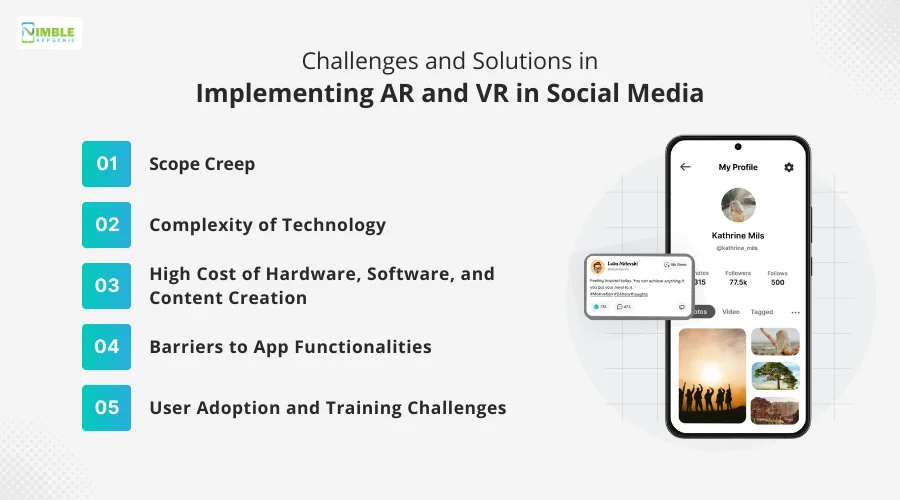
♦ Scope Creep
If your aim to implement AR/VR in the social media app is unclear, then it can have a large impact on the complete process to create AR/VR technologies for social media apps.
Lack of clear objectives will lead you nowhere. It will create a wide challenge for the businesses to lose their all resources.
♦ Complexity of Technology
The complexity of technology will have a large impact on your social media app. When you proceed with adding AR/VR features in the social media app, this can create complexity and a wide issue to implement the particular feature.
This issue can be wide if the selection of a team of developers is not appropriate. It will impact the complete resources that you have implemented in the project.
♦ High Cost of Hardware, Software, and Content Creation
One of the largest barriers that your social media app might face is the high cost of hardware, software as well as content creation.
When you adopt the AR-VR technologies in social media apps, it will undertake the high cost of hardware, software along with content creation.
Thus, this can result in raising the overall cost to create a social media app. This may create an issue in identifying the total ROI of your AR and VR in social media app.
♦ Barriers to App Functionalities
When you include a new technology for your social media app, this can create a new barrier to the overall app’s functions. Adopting these technologies can further impact the other features.
Thus, it will affect your overall dream app and can have a large impact on the users to navigate the app without any kind of errors.
♦ User Adoption and Training Challenges
Along with the technical challenges, there can be a barrier related to training the users related to the current usage of AR/VR technologies within social media apps.
Many users are still unaware of implementing such technologies in their favor. Thus, this can create a large challenge for the users.
These were some of the largest and biggest challenges that your business can face while adopting AR/VR in social media apps.
Well, let’s consider some of the major successful examples that will assist you in adopting AR/VR in social media apps.
Are you ready to proceed with the following section?
Successful Examples of AR and VR in Social Media Applications
With the examples of adopting and implementing AR/VR in social media apps, you can get an idea of how you can proceed with the project, right?
Well, here is the list of the best social media apps, to consider for examples.
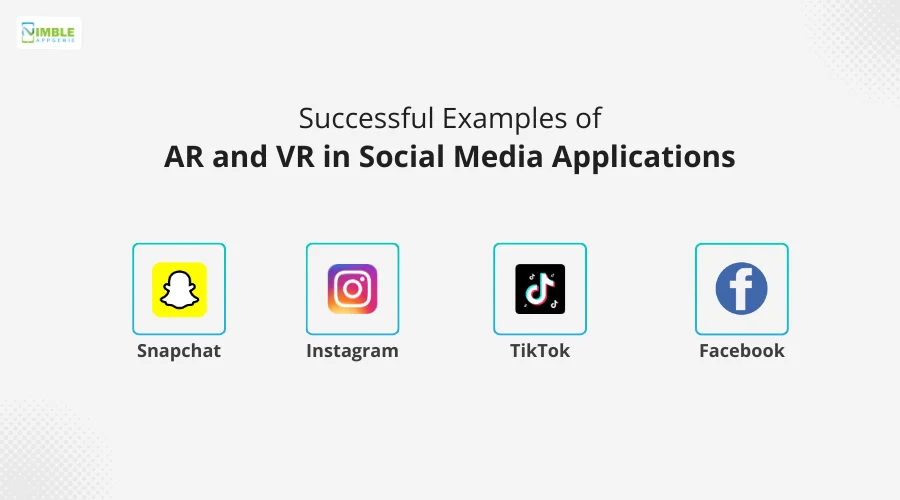
➤ Snapchat
The Snapchat platform uses AR to enable users a smiley face over the app by tapping on the camera screen, or just by scanning a Snapcode that will enhance a specific AR experience. This type of ad placement may occur after Snapchatters take a photo or video via Camera.
To evaluate the cost to create an app like Snapchat, you should know about the factors that are impacting the same.
Also Read: Snapchat Alternatives
Within Instagram, the AR art creator is a new feature that helps users build, share, and explore the art that mixes with the real world.
The app uses the power of AR technology to make digital art look like it’s a part of the real world.
To create an app like Instagram, you can continue with the adoption and implementation of AR/VR in the application.
This will help you to keep the users engaged and retain them for a long period.
➤ TikTok
By including the AR effects within TikTok platform, it has provided the users with easy-to-use editing tools that will create highly engaging content for keeping the viewers coming back for more.
You can scroll down to the best apps like TikTok to know more about how other similar apps are including such wide technologies for successfully increasing the user’s experience.
The implementation of AR/VR on Facebook keeps the users busy over mobile devices. It assists the users to have an effective experience by helping the users to engage with the users in real time.
You can develop an app like Facebook, after successfully evaluating how the app is using and implementing the AR/VR in the app.
Well, these are some of the examples you can consider while creating an AR/VR-based social media app.
Now, you can proceed with the future trends of AR/VR in social media. Let’s evaluate them all in the following section.
Future Trends of AR and VR in Social Media
When it comes to future trends of social media apps, AR/VR should be counted as one of them.
Now, for evaluating the future trends of AR/VR in social media, let’s find them all below.
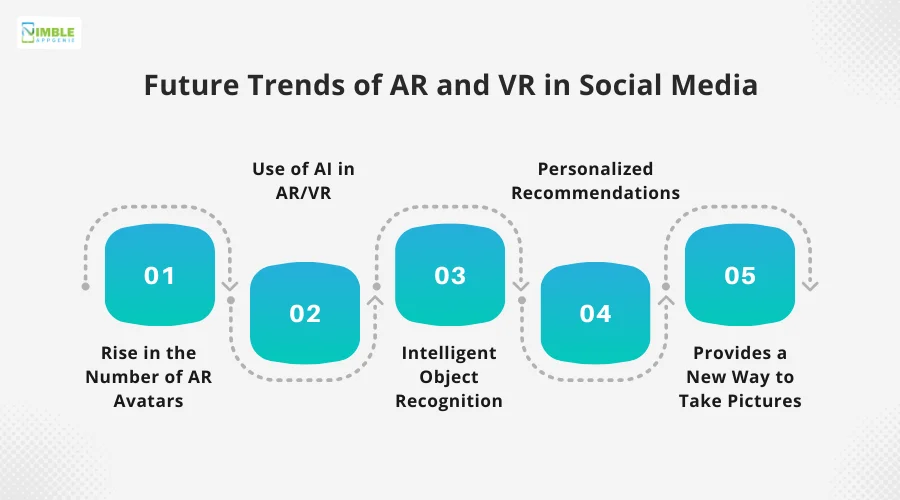
• Rise in the Number of AR Avatars
In the current era, people like the AR avatars that are assisting the users to successfully view themselves as one of the Avatars.
Thus, it creates an important scenario for the users to engage with the app through Avatars. Additionally, it is the future of AR that assists the users to adapt to more new and recent trends in technologies.
• Use of AI in AR/VR
The implementation and use of AI in AR/VR is the new trend that will follow in the future. It is one of the trends, where the users can experience realism, personalization, as well as functionality of AR and VR experiences.
Additionally, adoption of AI in social media can create realistic 3D model environments and even entire virtual worlds that will be based on the input data as well as generative models.
• Intelligent Object Recognition
In the future, social media apps can include AR/VR for intelligent object recognition. Such as when a user wants to know about an object, its use, and all the details with a few clicks, thus, with the help of AR/VR, they can address this issue among the users.
Social media app businesses can include this technology to successfully help the users identify the objects in the app.
• Personalized Recommendations
With the adoption and implementation of AR/VR technologies in social media apps, businesses can provide personalized recommendations based on current purchases and viewed products.
Such as over social media, you can display the user’s ads of the related products that they have recently searched over the platform. This helps the businesses to reach the users successfully.
• Provides a New Way to Take Pictures
By adopting multiple filters and improving them according to the users’ preferences, the adoption of AR/VR is assisting brands to take new pictures effectively.
AR can make social media apps more fun by helping users to provide a new way to take pictures. It is one of the essential strategies that can be helpful for the users to take pictures as they want to take them via AR or VR.
These were some of the important current trends to note when it comes to adopting AR, and VR for social media apps.
Now, connecting with an experienced team of developers can be helpful here.
Transform Your Social Media App With AR and VR – Powered by Nimble AppGenie
Searching for an experienced team of developers?
Nimble AppGenie is here to help you with all the essentials. We are the leading Social Media App Development Company providing honesty, and integrity, to convert your dream app into reality.
Our team is ready to help you with all assistance where we can help you with identifying the top features that you can use and implement as per the current market requirements and users’ demands.
We are ready to help you out by making strategies for your dream app to launch and even for maintaining the app.
Conclusion
When it comes to including AR and VR in social media apps, it can be confusing. However, you can include the same with the right strategies.
These can begin with the market analysis and can end with the launch of an app. There are multiple benefits that you can consider.
These can be such as user engagement, enhancing engagement with the users, personalization, and offering global reach to the audiences. Along with this, your business might face different challenges such as scope creep, complexity of technology, and many others.
Other than this, you can include various future trends to enhance the overall performance of the app.
These can be the rise in the number of AR avatars, the use of AI in AR/VR, personalized recommendations and it too provides a new way to take pictures.
FAQs

Niketan Sharma is the CTO of Nimble AppGenie, a prominent website and mobile app development company in the USA that is delivering excellence with a commitment to boosting business growth & maximizing customer satisfaction. He is a highly motivated individual who helps SMEs and startups grow in this dynamic market with the latest technology and innovation.
Table of Contents





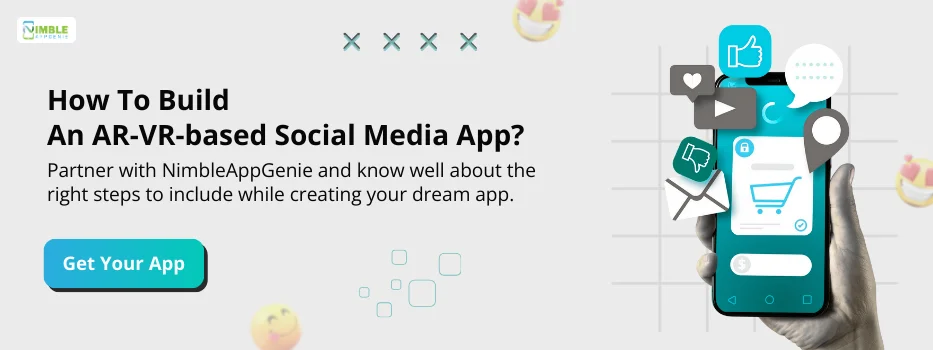
No Comments
Comments are closed.